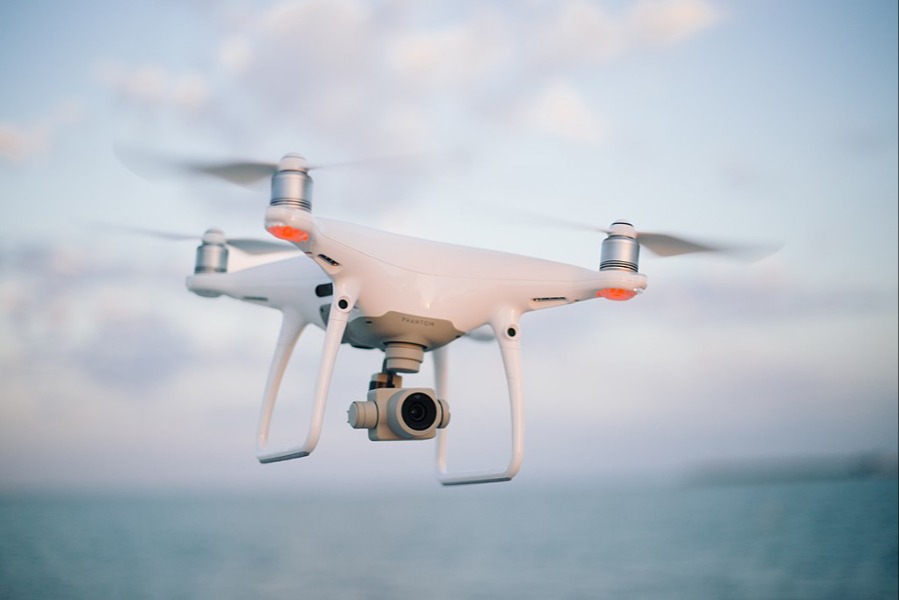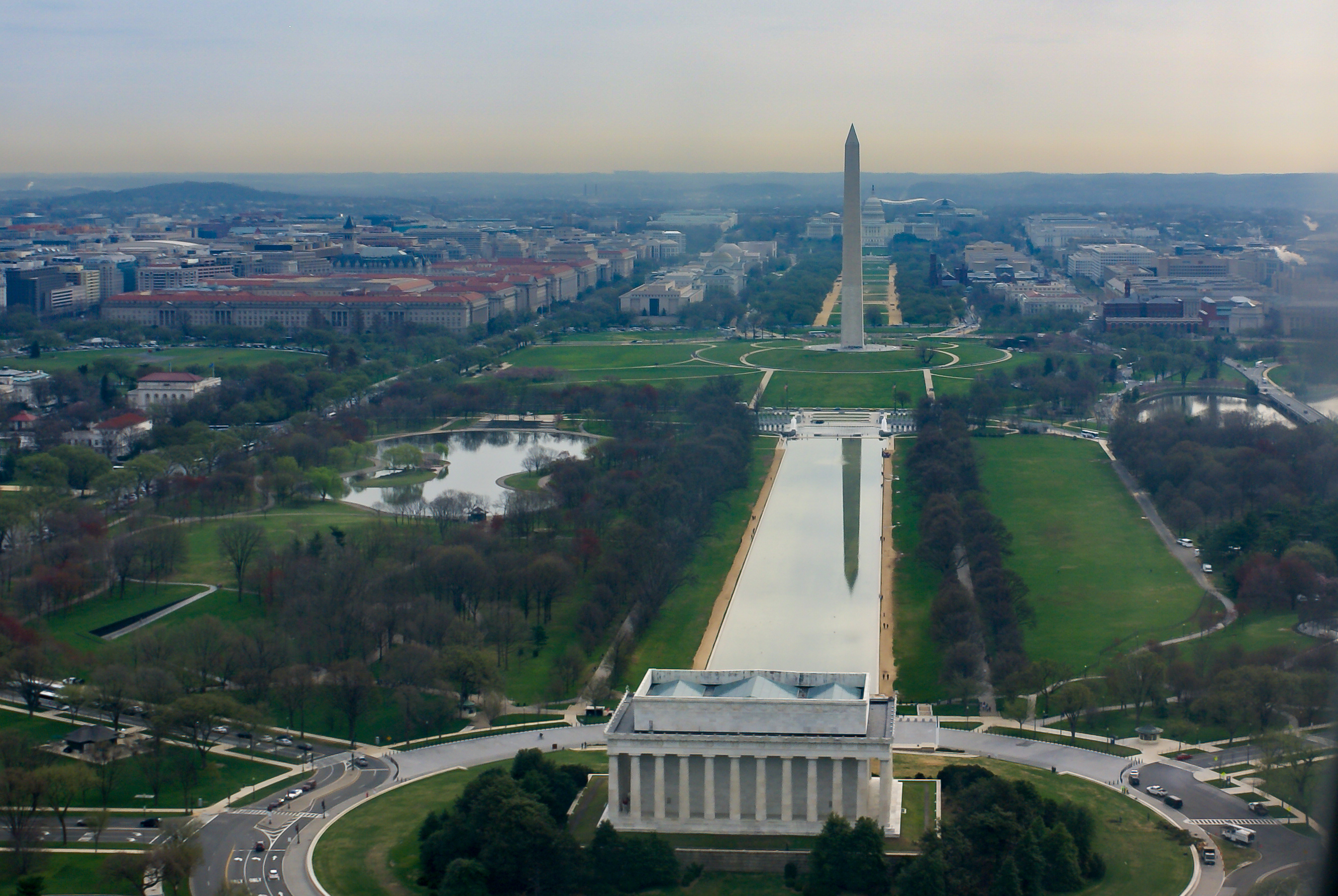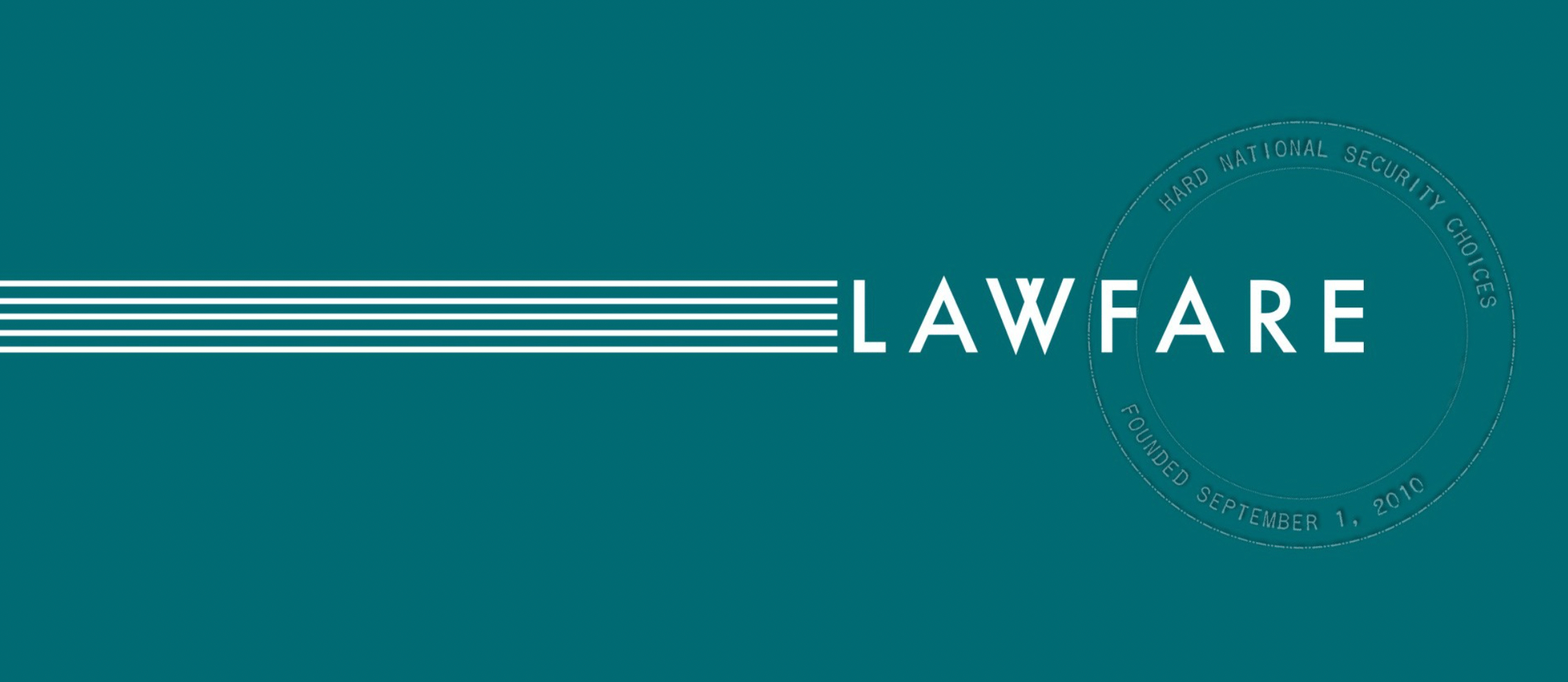Are Domestic Drone Shoot-Downs Lawful?
There are significant gaps in federal, state, and local governments’ authorities to intercept drones, though some fixes are on the table.

Published by The Lawfare Institute
in Cooperation With

Between November and December 2024, news articles reported widespread incidents of small- and medium-sized drones flying across northeastern U.S. states. As of mid-December, the federal government had received more than 5,000 reports of drone sightings. The Department of Defense and other federal authorities fielded questions about the reports from both Congress and the public, prompting investigations. By the end of December, however, it appeared that most of these alleged sightings were unsubstantiated. This round may have been much ado about not much.
Irrespective of whether these recent sightings were truly of drones, drone usage in the United States is only likely to increase in the months and years ahead. As a result, questions about whether and how federal, state, and local authorities can intercept or otherwise immobilize such drones are likely to persist.
During the recent spate of “sightings,” various U.S. officials supported shooting down drones found flying in U.S. airspace. New Jersey representatives were apparently “the first to call for the drones to be shot down.” Federal elected officials also demanded action. Sen. Richard Blumenthal (D-Conn.) said that authorities should “take them out of the skies, especially if they’re flying over airports or military bases.” President Trump and Rep. Marjorie Taylor Greene (R-Ga.) similarly suggested that the drones be shot down. Various actors have floated different options for actually engaging drones, ranging from the use of directed energy systems to signal interruption to physical nets.
What authorities to immobilize drones do U.S. federal, state, and local officials currently have, and—assuming Americans want at least some of those actors to have that authority—where are the gaps?
Federal Authorities
Federal officials have some statutory authorities to intercept, track, and bring down unmanned aerial systems (UAS). Under 10 U.S.C. § 130i, the secretary of defense can authorize military and civilian department employees to “[d]etect, identify, monitor, and track” as well as “disrupt control of,” “seize or otherwise confiscate,” or “use reasonable force to disable, damage, or destroy” drones that are threatening certain “facilit[ies] or asset[s].” These actors may take counter-UAS action pursuant to § 130i only to mitigate the threat that a UAS poses to a particular military or national security site. That is, the Defense Department cannot indiscriminately shoot down every drone that flies through U.S. airspace. This authority may also be tied to the fact that it is already illegal to fly personal drones within 400 feet of U.S. military sites.
An almost-identically worded statute, 6 U.S.C. § 124n, authorizes the Department of Justice and Department of Homeland Security to similarly engage threatening drones. The American Relief Act of 2025 extended those departments’ authorities, which would have sunset in December 2024, through March 2025. Like § 130i, this statutory authority requires that counter-UAS activity must be defensive in nature and connected to protection of specific sites that fall within Department of Defense and Department of Homeland Security mandates, such as prisons, federal courts, mass gatherings, and Coast Guard vessels.
Other federal sub-departments may also have defensive-focused authorities. Justice Department guidance authorized seven department components to engage in counter-UAS protection, drawing from the authorities contained in 6 U.S.C. § 124n: the Bureau of Alcohol, Tobacco, Firearms and Explosives; the Federal Bureau of Prisons; the Drug Enforcement Administration; the FBI; the U.S. Marshals Service; as well as the Justice Management Division and the Executive Office for United States Attorneys.
Beyond statutory authorities to intercept drones, federal regulations enable the Federal Aviation Administration (FAA) to regulate and track drone usage within the United States. The FAA has short-term options for contending with drone threats as well. In particular, it can issue temporary flight restrictions, which it did in December when it banned drone flights over critical New York infrastructure (in coordination with other federal authorities and at the request of New York Gov. Kathy Hochul).
Individual drone operators have legal obligations as well—and there are a lot of operators. The Pentagon’s press secretary reported that “more than 1 million drones” are registered and “that more than 8,000 drones are lawfully flown in the US every single day.” These operators are required to register drones that weigh between .55 and 55 pounds before operating them in national airspace. This number may not capture the full scope of drone activity and usage within the United States, however, as now-Justice Brett Kavanaugh authored an opinion on the U.S. Court of Appeals for the D.C. Circuit in 2017, holding that the FAA cannot require registration of “model aircraft,” which the relevant statute defines as an “unmanned aircraft that is (1) capable of sustained flight in the atmosphere; (2) flown within visual line of sight of the person operating the aircraft; and (3) flown for hobby or recreational purposes.”
In addition to registering their drones, drone owners must also “broadcast identifying information, including location and altitude, velocity, and location of the human controller.” This is part of the FAA’s “Remote ID” initiative. However, many drone operators may not be complying with these requirements, and it is unclear whether there are civil or criminal penalties for failing to do so. Meanwhile, other rules require drone operators to fly below 400 feet, obtain authorization to fly in controlled airspaces, and maintain visual sight of their drones at all times.
Gaps and Challenges
Despite these statutory and regulatory authorities, which provide a legal basis for federal departments and agencies to respond to certain threats posed by drones, there are practical and legal limits on the federal government’s ability to conduct counter-UAS operations.
First, the Defense Department has recognized that there is a significant amount of legitimate small drone usage that federal authorities do not seek to intercept or immobilize. In responding to questions about the recent reports of drone sightings, the Pentagon’s press secretary noted that “more than 8,000 drones are lawfully flown in the US every single day.” He emphasized that “flying drones is not illegal” and that “just as automobiles were a new technology once, so are drones, which can be flown for commercial use.” The use of drones for such commercial or recreational purposes does not represent a threat with which the government should interfere.
When drone usage does represent a genuine threat requiring government intervention, federal authorities may be limited in responding quickly and efficiently. For example, certain interception methods such as “RF and GPS jamming require coordination” between the military and “the FAA and other federal agencies.” While this ensures that federal efforts are not duplicative and are perhaps more effective because they are coordinated, this cooperation “could [also] slow down the reaction time among base security forces amid a potential drone incursion.” Some of the recent legislation (discussed below) seems to be targeted at enhancing interagency coordination in the face of a drone threat.
There are also intergovernmental challenges to intercepting drone threats. There is a lack of clarity among state and local officials about their authority to engage drones in the national airspace, or whether that power lies exclusively with federal authorities. Confusion during a real threat from unmanned aircraft could lead to duplicative efforts, confusion, or interference between the various operations. Alternatively, cumbersome coordination among federal, state, and local officials may be too slow and fail to mount a response in time. State and local authorities may lack the necessary information to respond or may be paralyzed from doing so out of concern that they would be violating federal law, which could inhibit any response at all if federal authorities are not themselves positioned to respond. Some of the legislation discussed below seems aimed at clarifying state and local entities’ authorities in these situations.
Beyond possible coordination challenges, federal authorities have expressed hesitance about leveraging counter-UAS capabilities that could pose a threat to civilians. The military has noted concern about using the same type of “surveillance and reconnaissance capabilities” that it deploys abroad while operating within the United States. The use of certain “solutions like missiles, guns, and other kinetic interceptors” are off the table “because there’s simply too much risk that they might end up inflicting collateral damage on innocent, unsuspecting civilians.” Thus, even at the moment of engagement and interception, there are limits on effective counter-UAS strategies that can be employed on American soil.
As a final challenge, authorities not only have expressed concern about the physical threat to civilians when intercepting drones but also have recognized Fourth Amendment and other surveillance-related limitations on intercepting communications of drone operators as part of their efforts to immobilize drone threats. There are limits and restrictions on federal law enforcement’s interception of communications without a warrant. So while certain technologies may be off limits because of the risk of civilian harm, others may be ruled out because of concerns about civil liberties and privacy.
Proposed Federal Legislation
Even before the surge of interest in addressing the perceived drone “invasion” in late 2024, federal officials had sought expanded statutory authorities to respond to threats from drones. Before leaving office, the Biden administration reiterated its hope that Congress would act on existing bills that have been introduced in both houses.
Federal legislation from the past few years appears to be responsive to at least some of the aforementioned challenges facing federal, state, and local law enforcement in responding to drone threats. A Senate bill introduced in March 2023, crafted in part to address UAS threats at commercial airports, explicitly conceptualizes integration of state and local action with federal authorities and separately ensures “coordination” among various federal departments and agencies. With regard to counter-UAS operations outside of airport facilities, the bill clarifies that a “State may ... carry out Counter-UAS activities for purposes of detecting, identifying, and mitigating the threats posed by an unmanned aircraft.” In fact, the final section of the act notes explicitly that it does not “abrogate the inherent authority of a State government or subdivision thereof from using their traditional police powers ... to counter an imminent threat to public health or safety.” A separate Senate bill introduced two months later also appears to respond to limits on federal agencies’ legal authority to intercept drones by purportedly providing “additional limited authority for detection, identification, monitoring, and tracking” while separately enhancing state and local law enforcement’s authority by envisioning a “pilot program for state, local, tribal, and territorial law enforcement.” This legislation, however, is still nascent.
Three other pieces of federal legislation have included provisions that appear to be more reactive to the recent drone sightings and that seek to enhance cooperation among federal agencies while also extending authorities for federal actors to engage drone threats. The joint explanatory statement for the Servicemember Quality of Life Improvement and National Defense Authorization Act of 2025 notes that the “agreement” contains a provision that “require[s] the Secretary of the Army, through the Joint Counter-small Unmanned Aerial Systems Office, to establish and maintain a threat library ... to coordinate efforts across the Department of Defense to counter unmanned aerial systems.” Meanwhile, the House has purportedly “posted” the FAA Reauthorization Bill, which seems to continue the authorities of the Department of Homeland Security and the FBI “to track and down drones that they deem a ‘credible threat’ to a ‘covered facility or asset.’” Finally, the funding bill that averted the most recent looming government shutdown reauthorized a Homeland Security program that allowed federal agencies to coordinate and counter threats from drones. It appears to have done so by “amend[ing]” the authorities in 6 U.S.C. § 124n to terminate in March 2025, rather than December 2024.
House Bill 8610: The Counter-UAS Authority Security, Safety, and Reauthorization Act
One particularly robust piece of legislation introduced in the House aims to expand government actors’ authorities and strengthen processes in the event of a drone threat. Only a few months before Americans began reporting drone sightings, the House introduced a detailed counter-UAS bill entitled the Counter-UAS Authority Security, Safety, and Reauthorization Act. This law focuses on the role of the Department of Homeland Security, the Justice Department, and the FAA—as well as the Department of Transportation within which the FAA is housed—in countering UAS threats and requires that they coordinate before acting. Through the bill’s provisions, such as the one establishing an Office of Counter-UAS Activities, it offers a more robust and coordinated counter-UAS approach, likely motivated by the idea that these threats will prove enduring. In fact, the anticipatory nature of this House bill—introduced only months before reports of increased drone sightings—demonstrates that federal lawmakers foresaw existing challenges to counter-UAS engagement. The bill expands on existing authorities and envisions novel ways of addressing drone threats.
First, it appears to add to the list of covered sites under existing law. Whereas 6 U.S.C. § 124n defines “covered facility or asset” as those primarily related to federal law enforcement and national security sites and missions, “covered site,” as defined by H.R.8610, includes “critical infrastructure, such as energy production ... and railroad facilities” as well as “oil refineries,” “amusement parks,” and “large public gathering[s].” Just as under existing law, the bill would not create broad federal authority to intercept drones generally; instead, officials still may only immobilize drones that are tied to threats to facilities and operations. Expanding the list of protected locations will increase the area of counter-UAS operations for federal authorities without providing an uncabined authority to intercept drones.
Second, the bill creates an Office of Counter-UAS Activities, housed within the FAA, which would serve as the FAA’s “primary point of contact for coordinating counter-UAS activities.” More broadly, the FAA would maintain primacy in determining whether a federal counter-UAS action would have “an adverse impact on aviation safety, [and] civil aviation.” By requiring coordination but also clarifying authorities of certain federal entities over particular decisions, this bill may ensure that in a moment of crisis, the order of operations is clear so that federal agencies can act both expeditiously and with necessary caution to safely counter a threat.
Third, this bill requires the Department of Homeland Security and the Department of Justice to generate a “list of approved makes and models of counter-UAS ... systems.” To that end, the authors of the bill articulate that there must be restrictions on the use of certain foreign-produced counter-UAS systems. Moreover, federal authorities can “test[]” and “train[]” systems to ensure that they are effective and, separately, establish training for those operating such systems. Designating effective systems that are not susceptible to foreign threats and ensuring that U.S. operators can actually deploy such systems to intercept threats may ameliorate concerns about operating counter-UAS systems in the United States, where there are heightened concerns about harm to civilians.
Fourth, this bill appears to recognize the desire and interest of state and local authorities in participating in counter-UAS activities. It requires the federal government to “establish a pilot program to assess the efficacy of approved counter-UAS mitigation systems at covered sites and determine” what is “necessary to allow State and covered local law enforcement agencies” to engage in counter-UAS activity. Any state or local action would need to be coordinated with the federal authorities. The state and local entities would apply to receive approval to use counter-UAS systems and would enter into agreements with the Department of Homeland Security “[u]pon approval of an application.” However, the only local law enforcement authorities that can participate are those that “ha[ve] jurisdiction over an area containing a population of at least 650,000 people.” In the event of an actual drone threat, the Department of Homeland Security would retain the authority to “verify that there is a justifiable threat that warrants the use of a counter-UAS system” and after the “mitigation of a UAS” does occur, the appropriate state or local entity would “submit” an after-action report to federal authorities. Ultimately, this pilot program would start small in terms of the number of participating state and local law enforcement authorities, with the ability to expand over time. Training and incorporating state and local authorities to respond to drone threats in coordination with federal authorities may engender quicker reaction times to drone threats and provide for greater coverage of the national airspace, while also ensuring that all authorities participating in counter-UAS activities act in close coordination and are uniformly trained to take action.
***
Congress seems likely to push forward with legislation that would expand federal, state, and local authorities to mitigate drone incursions within the territorial United States, given bipartisan concerns about recent drone sightings and bicameral efforts to propose legislation during the past two years. Pressure from the Trump administration may accelerate action on such bills. Allegations that such drones are being operated by foreign entities and potential concern about future incursions from foreign adversaries may also motivate expedited passage of legislation in the coming months.




krakd.jpeg?sfvrsn=c6e2ba28_5)

